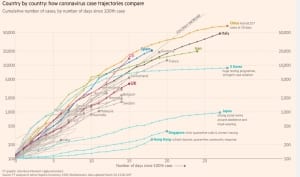Countries that do well in current crisis have good testing and a good system for tracking down of people who may have been infected
A previous post is entitled:
The post sums up key elements of the unfolding Covid-19 crisis. The first element concerns testing. The countries that do well in controlling the spread of infection have good testing and a systematic approach to the tracking down of people who may have been infected.

Source: John Burn-Murdoch
@jburnmurdoch
The second element concerns social isolation – the faster it is applied, and the more closely it is adhered to, the better the outcome will be.
Epidemiologist Larry Brilliant; COVID-19 testing in Canada; U.S. projections
Below is a selection of current stories related to testing and tracking down of infections.
A March 19, 2020 Wired article is entitled: “The Doctor Who Helped Defeat Smallpox Explains What’s Coming. Epidemiologist Larry Brilliant, who warned of pandemic in 2006, says we can beat the novel coronavirus – but first, we need lots more testing.”
A March 20, 2020 CBC article is entitled: “Why it’s so difficult to get tested for COVID-19 in Canada. Canadians already anxious about symptoms are surprised to learn they might not be tested for the virus.”
A March 20, 2020 New York Times article is entitled: “Without Urgent Action, Coronavirus Could Overwhelm U.S., Estimates Say.”
Status of testing in France
A March 21, 2020 Estonian World article is entitled: “Kristel Halman: Notes from the French war zone.”
An excerpt reads:
The numbers keep growing. Actually, it is useless to follow the numbers of infected people as France is not testing everyone any more, only the elderly, severe cases and medical staff.
Leaked email in Ontario, Canada
A March 20, 2020 Toronto Star article is entitled: “Leaked email reveals Ontario regional medical officer’s criticism of provincial COVID-19 strategy as cracks emerge in front line.”
An excerpt reads:
The tragedy of Italy now stands as a warning to its European neighbors and the United States, where the virus is coming with equal velocity. If Italy’s experience shows anything, it is that measures to isolate affected areas and limit the movement of the broader population need to be taken early, put in place with absolute clarity, then strictly enforced.
Despite now having some of the toughest measures in the world, Italian authorities fumbled many of those steps early in the contagion — when it most mattered as they sought to preserve basic civil liberties as well as the economy.Describing the province’s efforts to battle COVID-19 as piecemeal and ineffective, one of Ontario’s 34 regional medical officers of health is urging his colleagues to band together and use more powerful measures to contain the pandemic that provincial leaders have yet endorsed.
In an email obtained by the Star, Dr. Shanker Nesathurai wrote Thursday that Ontario’s response has undermined the province’s attempt to contain the outbreak, as businesses remain open and travellers ignore advice to self-isolate. He writes that “many” other medical officers of health, who are leading the regional response to the pandemic, believe Ontario needs to take a more assertive response.
Nesathurai called on his colleagues to use their legal authority to require businesses to close and people to stay home.“We do not have the luxury of time,” wrote Dr. Nesathurai, the medical officer of health for Haldimand Norfolk Health Unit.
Lessons from Italy
A March 21, 2020 New York Times article is entitled: “Italy, Pandemic’s New Epicenter, Has Lessons for the World. The country’s experience shows that steps to isolate the coronavirus and limit people’s movement need to be put in place early, with absolute clarity, then strictly enforced.”
An excerpt reads:
The tragedy of Italy now stands as a warning to its European neighbors and the United States, where the virus is coming with equal velocity. If Italy’s experience shows anything, it is that measures to isolate affected areas and limit the movement of the broader population need to be taken early, put in place with absolute clarity, then strictly enforced.
Despite now having some of the toughest measures in the world, Italian authorities fumbled many of those steps early in the contagion — when it most mattered as they sought to preserve basic civil liberties as well as the economy.
A second excerpt reads:
His political ally, Luca Zaia, the president of the Veneto region, pre-empted the national government with his own crackdown, and said that Rome needed to enforce “a more drastic isolation,” including closing all stores and prohibiting public activities other than commuting to work.
“Walks should be banned,” he said.
Mr. Zaia has some credibility on the issue. As new infections have proliferated around the country, they have significantly dropped in Vò, a town of about 3,000 people that was one of the first quarantined and which had the country’s first coronavirus death.
Some government experts attributed that turnaround to the strict quarantine that had been in place for two weeks. But Mr. Zaia had also ordered blanket tests there, in defiance of international scientific guidelines and the national government. The government has argued that testing people without symptoms is a drain on resources.

Leave a Reply
Want to join the discussion?Feel free to contribute!